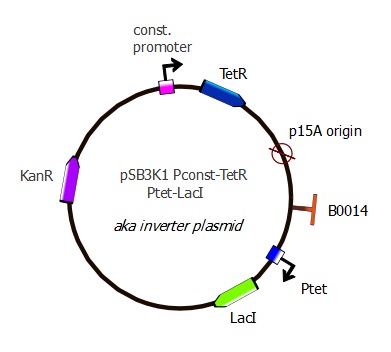Team:EPF-Lausanne/Our Project/Data
From 2011.igem.org
(→T7 Promoter Variants) |
(→T7 Promoter Variants) |
||
| Line 27: | Line 27: | ||
== T7 Promoter Variants == | == T7 Promoter Variants == | ||
| - | |||
| - | |||
| - | |||
| - | |||
| - | |||
| - | |||
| - | |||
| - | |||
| - | |||
| - | |||
| - | |||
| - | |||
| - | |||
| - | |||
| - | |||
| - | |||
| - | |||
| - | |||
== Other assemblies - without new biobrick == | == Other assemblies - without new biobrick == | ||
Revision as of 11:42, 17 September 2011
Data
That's how the Data page should look like: https://igem.org/Sample_Data_Page Perhaps we could only provide the link to the Registry page; if we put all the graphs here it's gonna be messy pages (TetR mutants, reporter plasmids and T7 variants) We can make a "results" page with all the graphs, or put them in the descript
Contents |
New parts
TetR Mutants
Lilia, are you also putting the WT into biobrick?
- V36F
Sequence
ATGTCCAGATTAGATAAAAGTAAAGTGATTAACAGCGCATTAGAGCTGCTTAATGAGGTCGGAATCGAAGGTTTAACAACCCGTAAACTCGCCCAGAAGCTAGGTTTCGAGCAGCCTACATTGTATTGGCATGTAAAAAATAAGCGGGCTTTGCTCGACGCCTTAGCCATTGAGATGTTAGATAGGCACCATACTCACTTTTGCCCTTTAGAAGGGGAAAGCTGGCAAGATTTTTTACGTAATAACGCTAAAAGTTTTAGATGTGCTTTACTAAGTCATCGCGATGGAGCAAAAGTACATTTAGGTACACGGCCTACAGAAAAACAGTATGAAACTCTCGAAAATCAATTAGCCTTTTTATGCCAACAAGGTTTTTCACTAGAGAATGCATTATATGCACTCAGCGCTGTGGGGCATTTTACTTTAGGTTGCGTATTGGAAGATCAAGAGCATCAAGTCGCTAAAGAAGAAAGGGAAACACCTACTACTGATAGTATGCCGCCATTATTACGACAAGCTATCGAATTATTTGATCACCAAGGTGCAGAGCCAGCCTTCTTATTCGGCCTTGAATTGATCATATGCGGATTAGAAAAACAACTTAAATGTGAAAGTGGGTCT
- P39K
- Y42F
- P39Q-Y42M
Sequence
ATGTCCAGATTAGATAAAAGTAAAGTGATTAACAGCGCATTAGAGCTGCTTAATGAGGTCGGAATCGAAGGTTTAACAACCCGTAAACTCGCCCAGAAGCTAGGTGTAGAGCAGCAAACAGTGATGTGGCATGTAAAAAATAAGCGGGCTTTGCTCGACGCCTTAGCCATTGAGATGTTAGATAGGCACCATACTCACTTTTGCCCTTTAGAAGGGGAAAGCTGGCAAGATTTTTTACGTAATAACGCTAAAAGTTTTAGATGTGCTTTACTAAGTCATCGCGATGGAGCAAAAGTACATTTAGGTACACGGCCTACAGAAAAACAGTATGAAACTCTCGAAAATCAATTAGCCTTTTTATGCCAACAAGGTTTTTCACTAGAGAATGCATTATATGCACTCAGCGCTGTGGGGCATTTTACTTTAGGTTGCGTATTGGAAGATCAAGAGCATCAAGTCGCTAAAGAAGAAAGGGAAACACCTACTACTGATAGTATGCCGCCATTATTACGACAAGCTATCGAATTATTTGATCACCAAGGTGCAGAGCCAGCCTTCTTATTCGGCCTTGAATTGATCATATGCGGATTAGAAAAACAACTTAAATGTGAAAGTGGGTCT
T7 Promoter Variants
Other assemblies - without new biobrick
J61002 Ptet-RFP
pSB3K1 Pconst-TetR
Description
This plasmid is the intermediary step before having the complete TetR plasmid. Here we only added TetR under constitutive promoter, wanting to add LacI under Ptet afterwards with a second Gibson. See the "assembly" page for more details.
Parts assembled:
- Plasmid backbone: pSB3K1 from ETHZ 2007 [http://partsregistry.org/wiki/index.php?title=Part:pSB3K1 "pSB3K1"] (taken from the delivery plate)
- Pconst: J23116 from Berkeley 2006 [http://partsregistry.org/Part:BBa_J23116 "j23116"] (sequence copied into our primers)
- RBS (B0034?) and spacer: (sequence copied into our primers)
- TetR: "TetR sequence" (623 bp) The sequence lacks a stop codon, we added TAA with our primers
Sequence
Complete sequence of the plasmid: "pSb3K1 Pconst-TetR"
Do we really need this? Sequencing data compared to the sequence of Pconst,RBS+spacer and TetR gene:"pSb3K1_TetR_seq" All these parts are correct.
Plasmid map
This plasmid contains a p15A replication origin as well as a Kanamycin resistance marker.
ATC induction
The platereader experiment was run for 12h, using 0-0.1-5-25-200-300-800-1000-1200-1500 nM/ul final concentrations of ATC. The cells were cotransformed with pSB3K1 Pconst-TetR and J61002 Ptet-RFP, to use the fluorescent protein as a readout for TetR inactivation by ATC. All the concentrations were tested on 4 different cultures, shown in the next graphs:
Dose-response
These data are coming from the same experiment; they show the saturation value of RFP expression for each ATC concentration. The values were averaged over the 4 different cell cultures.
pSB3K1 Pconst-TetR Ptet-LacI
Description
This is the final TetR plasmid, containing the TetR gene as well as the LacI inverter with a Ptet promoter. Here we have wild-type TetR and Ptet sequences, but this plasmid is also intended to be used with mutant TetR genes and mutant Ptet binding sequences.
Parts assembled
- Plasmid backbone containing Pconst and TetR: see precedent section
- Terminator: B0014 from the Registry [http://partsregistry.org/Part:BBa_B0014 "B0014"] (sequence copied into our primers)
- Ptet: R0040 from Registry [http://partsregistry.org/Part:BBa_R0040 "R0040"] (sequence copied into our primers)
- LacI: amplified from Repressilator plasmid "LacI sequence" The sequence lacks a stop codon, we added TAA with our primers.
Sequence
Add results for TetR sequencing Add results for LacI asap
Plasmid map
This plasmid has the same structure as pSB3K1 Pconst-TetR: p15A replication origin and Kanamycin resistance marker. However, Ptet-LacI has been added after the p15A sequence.
ATC induction
ATC dose-response curve
IPTG induction
IPTG dose-response curve
 "
"






